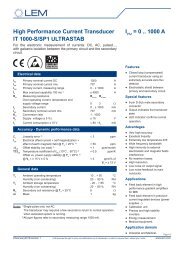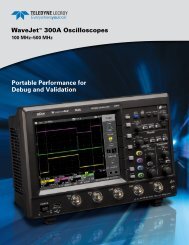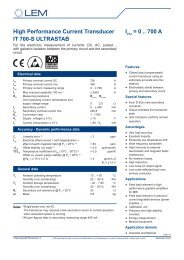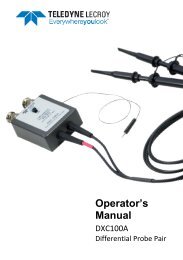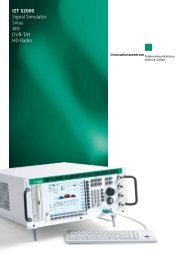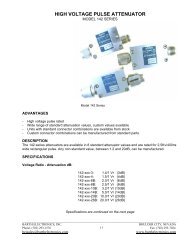DA 1855A - Operator's Manual - Teledyne LeCroy
DA 1855A - Operator's Manual - Teledyne LeCroy
DA 1855A - Operator's Manual - Teledyne LeCroy
You also want an ePaper? Increase the reach of your titles
YUMPU automatically turns print PDFs into web optimized ePapers that Google loves.
Operator’s <strong>Manual</strong><br />
When used without ProBus interface, the instrument can be set to factory default settings by<br />
pressing the VCOMP and VDIFF buttons simultaneously.<br />
Gain<br />
X1<br />
Attenuation ÷10<br />
+ Input Coupling Off<br />
– Input Coupling Off<br />
Bandwidth Limit<br />
PVG Voltage<br />
V COMP<br />
V DIFF<br />
Input Resistance<br />
PVG Mode<br />
Full<br />
+00.000 V<br />
Off<br />
Off<br />
1 MΩ<br />
Roll through zero<br />
Table 4. Factory Default Settings<br />
Sensitivity, Position and Offset<br />
Oscilloscopes are designed to maintain their accuracy for that portion of a signal that is displayed<br />
on-screen. When the signal is large enough to drive the display off-screen, the oscilloscope’s<br />
amplifier must limit the signal in a non-linear mode. Oscilloscopes are designed so that no matter<br />
how the sensitivity, position and offset controls are set, the operator cannot view this distorted<br />
portion of the signal.<br />
When used with a <strong>Teledyne</strong> <strong>LeCroy</strong> oscilloscope, the setup is automatic to prevent you from<br />
entering a mode which could result in displaying a distorted signal resulting from overload.<br />
When used with instruments lacking ProBus interface, the instrument’s gain and position controls<br />
should be properly set to avoid displaying the non-linear portion of the <strong>DA</strong><strong>1855A</strong>'s output signal<br />
when it is in overdrive. This can be accomplished by observing the following rules:<br />
<br />
<br />
Turn the oscilloscope input coupling to “OFF” or “GND”, set the oscilloscope position<br />
control to center screen, and do not change it! If the oscilloscope has an OFFSET control, it<br />
too should be set to zero. Return the oscilloscope’s input coupling to “DC”. Subsequently<br />
adjust the trace position on the oscilloscope screen using the <strong>DA</strong><strong>1855A</strong> PVG and V DIFF mode<br />
or V COMP input. This assures that the oscilloscope is set to the center of the <strong>DA</strong><strong>1855A</strong>'s<br />
dynamic range.<br />
Set the oscilloscope deflection factor to no greater than 100mV/div. The most useful range<br />
for the oscilloscope deflection factors will be between 1mV/div and 100mV/div. Using a<br />
scale factor of 200 mV/Div will allow the nonlinear portion of the <strong>DA</strong><strong>1855A</strong>'s output to be<br />
viewed on screen.<br />
922258-00 Rev A 21



